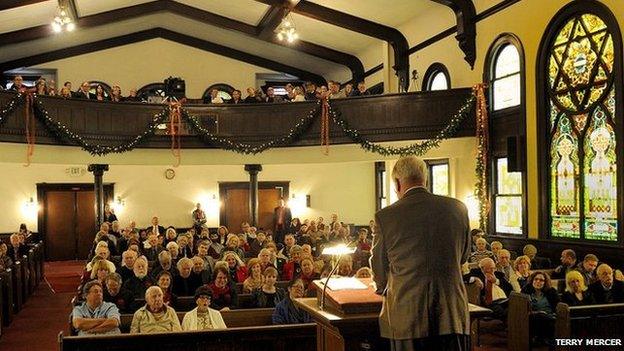Welsh church in Los Angeles holds final Sunday service
- Published

Full house: the Welsh church in Los Angeles was packed for its last Sunday sermon on 16 December
A Welsh church in Los Angeles has closed after 120 years due to a dwindling number of parishioners.
In its heyday the Welsh Presbyterian Church saw a congregation of up to 300 immigrants through its doors on Sunday for services in Welsh and English.
But over the years that number has been reduced to about 10 regulars.
The closure has been partly blamed on social changes with new generations not interested in maintaining chapel traditions, one parishioner said.
Welsh church members, who held their final service earlier in December, said they will still have access to the building as it is being taken over by a community group.
"The Welsh church prospered for many years but in the last few years membership decreased," says Frank Williams, chair of the church's board of trustees for the last 15 years.
The aging congregation is no longer able to travel long distances to get to church while other families have moved away over the years, he said.
However, there was once a strong Welsh community in LA and the wider southern California area, added Mr Williams who left Wales to work for Boeing aircraft in 1967.
The church was founded in 1888 by the Reverend David Hughes from Llanuwchllyn, Gwynedd, and was originally located at another building.
Hughes founded two churches, one for English speakers and another for Welsh speakers.

Parishioner Dafydd Evans calls the church 'a small part of Wales' in LA
The first lost its Welsh identity long ago, according to the church website, external.
And the second became the present Welsh Presbyterian Church which started with 22 Welsh immigrants in the back of a store before moving to its first church.
In 1926, a bigger building was needed for the growing congregation and a Jewish synagogue built at the turn of the century became its new home.
It was bought by two churchmen on behalf of the congregation and continued to play a central role in the lives of Welsh people and their descendants as LA continued to be developed.
Up until 30 years ago the church maintained many Welsh traditions, including having a successful choir, according to Mr Williams.
He said its "crowning achievement" was singing in the Oscar winning 1940s Hollywood film, How Green Was My Valley, about life in a south Wales mining community.
Today, the church is registered as a historical building.
Welsh church parishioner Dafydd Evans from Manhattan Beach, California, said the building retains many of its original features.
Mr Evans, whose granddaughters were the last to be baptised in the church, said due to deaths and members moving away from Los Angeles, the congregation is down to "less than 10 people coming each Sunday and we're all senior citizens".
He said: "It is ironic that a leader of the Jewish community has bought the building and plans to upgrade the property and use it for cultural activities and religious services.

The church building maintains many original Jewish features
"It will include the local community and also us, the Welsh, if and when we need the building.
"So the lovely old place will continue to serve and I'm sure will be loved for many years to come."
Mr Evans, originally from Nantymoel in the Ogmore Valley, has researched the Welsh church's history and its record books - in English and Welsh - show that community met in various buildings before a permanent building was secured in 1893.
The last full-time minister retired in 1964.
Mr Evans said: "What is Los Angeles losing now that the Welsh church is closing?
"Well, of course, there is the loss of a spiritual home... and a small part of Wales.
"We have been very fortunate to have not only to have Welsh and Welsh Americans in our congregation, but also English and Americans with no Welsh family connections," said Mr Evans who emigrated with his wife and children in 1964.
"What we've been lacking are the young Welsh immigrants who tell us that they didn't go to chapel in Wales and weren't going to start here."

The Welsh church's more regular parishioners pose for a final photograph
- Published31 March 2012